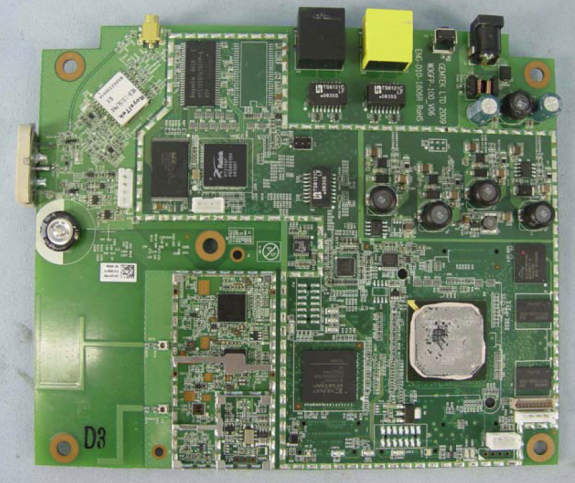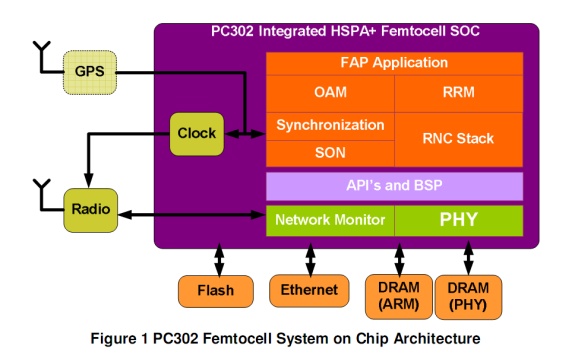AT&T 3G MicroCell: A Comprehensive Exploration
by Brian Klug on April 1, 2010 1:55 AM EST- Posted in
- Smartphones
- AT&T
- Microcell Review
- Mobile
Inside that white shell
So we now know there's relatively little to be learned about the device on the software side. What about the hardware itself? Again, our semiconductor-possessed sensibilities wouldn't be happy unless we got to see what's at this thing's core. I was eager to tear open the box and void some warranties like nobody's business, until I discovered something while doing my homework online that made me stop. Several users on the AT&T Forums reported that they were called by tech support because their MicroCell's tamper switch had been triggered. You read that right, the MicroCell has a built in physical tamper switch. They're that serious about you not getting into this thing. Rather than render the box useless before I even got to use it, I decided on another route.
Instead, I got the FCC ID off the bottom of the box (it's MXF-3GFP980217) and found the FCC filing online. Luckily, the internal photos of the device are freely available and of marginally passable quality. The most important photo is this one, of the board's topside with the heatsink removed:
That's some horrendous barrel distortion, FCC cameraman
I've tried locating the physical tamper switch and can't quite find it, though I'm certain it's there somewhere. Starting from the left, we can see the GPS chipset (RoyalTek) and the external connector just above it. There's also a trace to the Cirocomm internal GPS antenna which is the white square protruding from the board at far left. Running along the top of the board are the two ethernet connectors, reset pin, and DC power in. On the left we can also see two relatively thick traces for the antenna, likely Rx and Tx for the air interface. Interestingly, there are some connector headers also visible at the base of where those traces emerge from the amplifiers. Just south of the GPS RoyalTek chip is a flash TSOP, a Ralink RT2150F chip, and some DRAM up top. Searching for that particular Ralink chip revealed nothing. Given that Ralink traditionally makes wireless access point SoCs and wireless adapters, it's possible this is the device's radio. It's also possible that this is handling routing and ethernet for that "priority mode" configuration mentioned earlier.
Moving right, there's something we don't see every day - except in the domain of high speed signal processing - a Xilinx Spartan 3A FPGA sitting right alongside the platform's SoC. If you squint, you can make out picoChip under that thermal paste, along with 302. It's highly likely this board is using the picoChip PC302 SoC. Remember that 4 simultaneous phone limitation earlier? The PC302 is the only 3GPP Release 7 WCDMA (HSPA) SoC baseband picoChip makes with that implicit restriction, so it's very likely this is what we're seeing here. There's some RAM alongside at right, but it's impossibly hard to make out the markings.
The PC302 is the core of the MicroCell, incorporating a 400 MHz ARM11 processor as well as hardware accelerator support for IPsec, ethernet, and everything you need for a femtocell. Unsurprisingly, picoChip calls this a WCDMA Femto Access Point (FAP) supporting up to 4 users, and 21 Mbps HSDPA, 5.7 Mbps HSUPA. Keep in mind here that although the controller supports a physical layer data rate at those speeds, the air interface, protocol, and implementation limit the speeds further. We'll see that in practice, speeds are lower.












63 Comments
View All Comments
A beautiful mind - Thursday, April 1, 2010 - link
My Nokia N900 already uses the home/office wifi connection to access the internet, with the possibility to receive/make calls from/to skype.There is absolutely no extra functionality that is provided by the femtocell approach.
softdrinkviking - Thursday, April 1, 2010 - link
For you and me, this is true.But not for everyone.
That's the really sad thing about this device. It's designed as a way to nickel and dime poor souls whose homes are in a dead zone and absolutely have to answer their phone for business.
nafhan - Thursday, April 1, 2010 - link
Great article, and you did an excellent job of diving into the tech behind the femtocell.An interesting follow up to this article might be to see what kind of results you get from purchasing an antenna and repeater. I've seen antenna/repeater setups online in the $350 and up range, and wondered how they would do. If they work OK, it might be a viable alternative, especially for people without good internet connections.
gwolfman - Thursday, April 1, 2010 - link
Where is the print article feature on the new site?Maroon - Thursday, April 1, 2010 - link
They've been sneaking these things in Apple stores. No wonder the iPhone feelgood only lasts untill you get out of the store and have to rely on the "standard" AT&T network. LOL.soccerharms - Thursday, April 1, 2010 - link
Are you kiddin' me? I am going to approach this from two angles. The first being that this article is completely fake. ITS APRIL 1st people! The tech community should have an uproar for such a device. We buy internet and it is usually our responsibility to distribute it around the house with a router for wireless and whatnot. HOWEVER, we do not buy a wireless......phone plan with the intention on increasing a carriers crappy signal in our own house out of our pocket. That's ludacris! There is another much cheaper solution...........its called a LAN line with a cordless phone HA!The only company that could profit from a device like this would be Apple. But they would have to make it a little more shiney and put that quarter eaten logo on the side :)
Let the battles begin....
Jaybus - Thursday, April 1, 2010 - link
This is like buying an airline ticket only to find there is no flight. Since they don't have a flight, the airline offers to sell you your own airplane. You have to provide your own pilot, fuel, and maintenance, but you still have to pay them the full price for a ticket whenever you fly your own airplane. So my idea is to start a car rental business that has no cars. Anyone willing to pay AT&T for a microcell that uses their own Internet connection would surely be willing to pay me a rental fee for driving their own car.HotFoot - Thursday, April 1, 2010 - link
Eh... much of this market is iPhone users - people already willing to accept the concept of ecosystem lock-in. By a similar analogy to your car rental company, they're already willing to buy a car from a company that requires that they drive only on roads built or approved by that company, buy gas only at that company's stations, and buy car insurance from that company.Why not charge them for the roadside delivery of a jerry can of gas when the customer finds out the station filled their tank with water instead of fuel?
yacoub - Thursday, April 1, 2010 - link
I give it a year or two before the first cancer danger report comes out. ;)loydcase - Thursday, April 1, 2010 - link
AT&T cell reception at my house is weak in spots. OTOH, if a femtocell allows me to rip out my landlines, it might be worth it. So I'd like to know if a femtocell would be viable for that purpose.